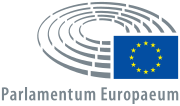Europaparlamentsvalet i Tyskland 2014
| Val till Europaparlamentet 2014 | |
| Område Antal mandat Valdagar | 96 25 maj 2014 |
| Valmanskår Valdeltagande | 62 004 092 48,12 % |
| Valsystem Valmetod Spärr | proportionellt valsystem Hare-Niemeyers metod ingen |
| Andra val Föregående val Nästkommande val | Europaparlamentsvalet 2009 Europaparlamentsvalet 2019 |
Europaparlamentsvalet i Tyskland 2014 ägde rum söndagen den 25 maj 2014. I juni 2013 beslutade Tysklands förbundsdag att sänka spärren för att partier ska kunna erhålla mandat i valet från tidigare 5 procent till 3 procent med anledning av en dom från författningsdomstolen.[1] I februari 2014 underkände författningsdomstolen även treprocentsspärren, vilket öppnade möjligheten för små partier att ta mandat.[2]
Opinionsmätningar
| ||||||||||||||||||||||||||||||||||||||||||||||||||||||||||||
Valresultat
| Andel | Antal | Mandat | ||
| CDU | 30,02 % | 8 807 500 | 29 | |
| –0,63 % | +736 109 | –5 | ||
| Socialdemokraterna | 27,27 % | 7 999 955 | 27 | |
| +6,48 % | +2 527 389 | +4 | ||
| Allians 90/De gröna | 10,70 % | 3 138 201 | 11 | |
| –1,44 % | –56 308 | –3 | ||
| Die Linke | 7,39 % | 2 167 641 | 7 | |
| –0,09 % | +198 402 | –1 | ||
| Alternativ för Tyskland | 7,04 % | 2 065 162 | 7 | |
| +7.04 % | +2 065 162 | +7 | ||
| CSU | 5,34 % | 1 567 258 | 5 | |
| –1,86 % | –329 504 | –3 | ||
| FDP | 3,36 % | 986 253 | 3 | |
| –7,61 % | –1 901 831 | –9 | ||
| Freie Wähler | 1,46 % | 428 524 | 1 | |
| –0,22 % | –14 055 | +1 | ||
| Piratpartiet | 1,45 % | 424 510 | 1 | |
| +0,58 % | +195 046 | +1 | ||
| Tierschutzpartei | 1,25 % | 366 303 | 1 | |
| +0,15 % | +76 609 | +1 | ||
| NPD | 1,03 % | 300 815 | 1 | |
| +1,03 % | +300 815 | +1 | ||
| Tysklands familjeparti | 0,69 % | 202 871 | 1 | |
| –0,27 % | –49 250 | +1 | ||
| ÖDP | 0,63 % | 185 119 | 1 | |
| +0,12 % | +50 226 | +1 | ||
| Die Partei | 0,63 % | 184 525 | 1 | |
| +0,63 % | +184 525 | +1 | ||
| Övriga partier och kandidater | 1,76 % | 516 063 | 0 | |
| –3,91 % | –976 079 | ±0 | ||
| Ogiltiga och blanka röster | 1,66 % | 496 216 | 0 | |
| –0,53 % | –93 954 | ±0 | ||
| Valdeltagande | 48,12 % | 29 836 916 | 96 | |
| +4,85 % | +2 913 302 | –3 | ||
| Antal röstberättigade 62 004 092
| ||||
Källa: [4]
Se även
Referenser
Noter
- ^ ”Germany lowers threshold for European Parliament entry” (på engelska). EUbusiness. 14 juni 2013. http://www.eubusiness.com/news-eu/germany-parliament.p5h/. Läst 20 juni 2013.
- ^ ”Beslut öppnar för tyska småpartier i Europaparlamentet”. Dagens Nyheter. 26 februari 2013. http://www.dn.se/nyheter/varlden/beslut-oppnar-for-tyska-smapartier-i-europaparlamentet/. Läst 26 februari 2014.
- ^ [a b c d] [1]
- ^ ”Bundesergebnis - Vorläufiges Ergebnis der Europawahl 2014” (på tyska). Der Bundeswahlleiter. 28 maj 2014. Arkiverad från originalet den 28 maj 2014. https://web.archive.org/web/20140528001328/http://www.bundeswahlleiter.de/de/europawahlen/EU_BUND_14/ergebnisse/bundesergebnisse/index.html. Läst 28 maj 2014.
| |||||||||||||||||||||||||||||||||||
| EU-portalen – temasidan för Europeiska unionen på svenskspråkiga Wikipedia. |
Media som används på denna webbplats
The Flag of Europe is the flag and emblem of the European Union (EU) and Council of Europe (CoE). It consists of a circle of 12 golden (yellow) stars on a blue background. It was created in 1955 by the CoE and adopted by the EU, then the European Communities, in the 1980s.
The CoE and EU are distinct in membership and nature. The CoE is a 47-member international organisation dealing with human rights and rule of law, while the EU is a quasi-federal union of 27 states focused on economic integration and political cooperation. Today, the flag is mostly associated with the latter.
It was the intention of the CoE that the flag should come to represent Europe as a whole, and since its adoption the membership of the CoE covers nearly the entire continent. This is why the EU adopted the same flag. The flag has been used to represent Europe in sporting events and as a pro-democracy banner outside the Union.European Parliament logo



